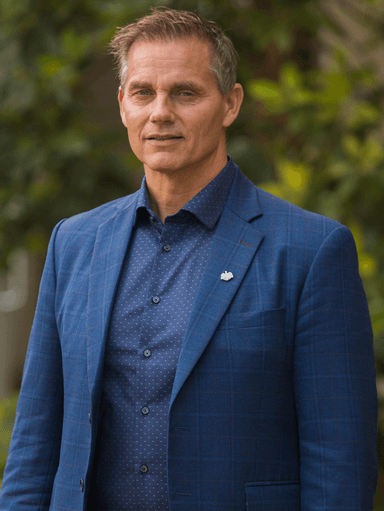Bob Byrne
I’m originally from a tiny town in Upstate New York. We literally had more cows than people. Growing up, I was great at causing trouble but even better at getting out of it. The law seemed like a natural career fit. Coming out of law school, I knew only one thing about my future career: I would never, ever be a personal injury lawyer. Two things changed that. The first was when a conservative judge I was clerking for explained that the McDonald’s hot coffee case was an extremely meritorious case. That changed my perspective. The second was when I suffered an unexpected and staggering loss of a loved one. That changed my heart. I handle a variety of catastrophic injury cases in the trucking, medical malpractice, auto, and premises spaces. I love what I do, and it is one of my greatest blessings that I’m able to try cases with my incredibly able wife.
Try your FRKN Case
Hosted by Lloyd Bell
Monte Tynes - Brown v. Keith, et al
$931,875.00 verdict on a $25,000.00 offer on a rear-end collisions case of less than 5 mph with no property damage to either vehicle.Police were not called to the scene and no medical treatment until the next day.Client had significant 10-year history of pre-existing low back injury.
Turning points:
- Opening Framing of the case – “Broke the law and caused a crash, looking for a free pass because the victim had been injured before.”
- No remorse from Defendant – 1st witness
- Demonstratives used to show injuries
- Independent witness to verify severity of injuries (program director of volunteer group)
- Defense’s cross of the Plaintiff shows medical bills include medical treatment for stuff that clearly was not caused by the crash, treatment for injury for 10 years up to the year before the injury, and medical records that showed she had the same complains before the crash as she had after the crash
- Closing – Being honest and admitting a mistake we made in the trial regarding medical bills
Bob Byrne - Our client was a 36-year-old college professor who was driving her SUV on a four-lane highway with her four kids. She slowed down with traffic. Behind her was a large, commercial dump truck that maintained speed and came upon the slowing traffic. The dump truck swerved and smashed into the side of our client’s car.
Our client was found to be alert and oriented at the scene. She went to the ER, complained of bumps and bruises, and was released that day. She and her family then checked into a local hotel where they stayed for four days. Our client could not bear to get back into a car to drive home, though home was only 30 minutes away.
We contended that our client had a mTBI and PTSD. Our client claimed that her life changed after the crash. She claimed that her teaching was impacted, and some student reviews supported that. But, four months after the crash, she was given tenure and promoted. Two years after that, however, she resigned from her position and took an assistant principal position with a small, private school for children.
At trial, the defense claimed that our client’s problems were due to her long-standing problems with anxiety. Our client had been given medication for anxiety before the crash but was not always compliant. The defense pointed out that she had marital problems before the crash, she had a demanding and stressful job, she was raising kids in a blended and interracial marriage, etc. They pointed to several times before the crash that she had been overwhelmed with life.
The highest defense offer before trial was $125,000. The jury awarded $1.75M plus pre-judgment interest of approximately $471,000, for a total verdict of $2.2M.
Here are the teaching points for the session:
- Make the trial not just a battle of credibility, but a battle of integrity. Expose the defense’s lack of integrity by showing that their claim to accept responsibility is not true, their witnesses cut corners, they ignored material evidence but focused on immaterial evidence, etc. We do a sort of polarizing the integrity of the case that we’ve found to be effective.
- As I learned from Jakob Norman at TLU Vegas a couple years ago, start the closing around the verdict form. It is the most important document in the whole case. “Verdict” means to speak the truth, but the form allows only a number to be written. Not an essay, not a speech. Just a number. That’s incredibly powerful and helpful.
- If your jurisdiction requires detailed expert reports (like in federal court), don’t take the defense expert’s deposition before trial (unless for housekeeping purposes or unless you want to blow the expert up to facilitate a settlement). If you do, the expert will see the weak points of their position and bolster those for trial. Perhaps more importantly, you want to make the expert uncomfortable and you want their body language to change when you do cross examination. The expert will feel far less comfortable if they are not accustomed to how you view the issues in the case, your rhythms, your cadence, your energy, etc. The jury may not get all of the nuances of the case, but they will see the expert squirm. You want the jury to see that discomfort and the inconsistency between the expert in direct and the expert in cross.
- Don’t value a case like how the defense does. The defense is all about diagnosis, ICD codes, CPT codes, and other quantifiable labels that fit into an algorithm. But the deliberation room is not equipped with computers, actuarial tables, artificial intelligence, etc. It is seven people sitting around a table valuing things based on their individual and collective experiences and values. We can’t make the mistake of falling into the defense’s way of doing things and focusing on the clinical aspects of the case as opposed to the stark ways the injury has impacted our client’s life. This is especially true with mild TBI claims, which can be very nuanced injuries.
- After exposing the battle of the case, ask the jurors for help. Unless a juror has a strong personal sense of justice that is implicated by the case, they will not necessarily feel invested to fight for a stranger. Fighting for a stranger is awkward in our society, where our default position is to be apathetic or to avoid conflict out of a sense of making peace. But asking jurors to fight empowers them – it gives them permission to have a stake in the fight and helps them see the importance of their work.
- Be willing to have “trojan horse” expert witnesses that you do not call at trial. In our last couple of trials we learned that the defense planned to launch withering attacks on two of our expert witnesses. In fact, we could tell that the defense planned to make those attacks the centerpiece of their defense based on the massive posterboards the defense brought into the courtroom. Both of our experts performed poorly in their depositions and if they performed poorly at trial it could have irreparably undermined our integrity and credibility. After concluding that we could get the experts’ anticipated evidence in through other ways, we elected at the last minute to drop both of those experts. The defense was flat-footed, and the jury was left with the lasting image of the defense having these massive posterboards at trial that they never used.
- If the defense expert only does a records review but does not actually examine the client, use the “negative space” technique to expose the weakness of their opinions. At this trial the defense expert did not examine the witness and testified in front of the jury that Lauren, my wife and co-counsel who was seated at counsel table, was the client. We set that up and actually had the jury laughing during closing..
George Moschopoulos & Andrew Ryan - White v. Rockport, et al. Verdict was $1.2M
Case description is as follows: Malissa White was employed as a nurse at nursing home where she was asked to participate in a Medicare fraud scheme. She reported the scheme to her employer and to the state, but her employer took no corrective action. Instead, her employer continued to require her to participate in the scheme. She refused and resigned. She filed suit claiming constructive discharge, or that she was illegally forced to quit. She found a job that paid her more than 25% of her prior salary within two weeks following her resignation. She made claims for non-economic damages only, but had not sought or received any medical treatment. Trial opened on Monday and a verdict was reached by Friday afternoon of that same week.
Here are our teaching points:
- The importance of focus groups and “losing” your case.
Cutting trial down to the bare essence. - Asking for non-economic damages when there is no treatment and the plaintiff earns more money at a new job.
- Understating your case in mini-opening.
- Making the ask in closing argument.
- Dealing with a difficult judge.
- Sealing the deal in rebuttal.
TLU Live HB Agenda
Track 1
Breakfast
Hosted by
- 9:00a




 Will Sykes · Dorothy Clay Sims · Sach OliverDepositions
Will Sykes · Dorothy Clay Sims · Sach OliverDepositions Coffee & Snacks
Hosted by
- 10:15a




 Will Sykes · Dorothy Clay Sims · Sach OliverDepositions
Will Sykes · Dorothy Clay Sims · Sach OliverDepositions Coffee & Snacks
Hosted by
- 11:30a




 Will Sykes · Dorothy Clay Sims · Sach OliverDepositions
Will Sykes · Dorothy Clay Sims · Sach OliverDepositions Lunch
Sponsored by
- 2:00p


 Christian Augustin · Sean Claggett Intake and Pre-Lit Workup
Christian Augustin · Sean Claggett Intake and Pre-Lit Workup Coffee & Snacks
Hosted by
- 3:15p





 Shannon Wise · Jennifer Morales · Brian BlankenshipManaging the Case and Putting Constant Pressure on the Defense
Shannon Wise · Jennifer Morales · Brian BlankenshipManaging the Case and Putting Constant Pressure on the Defense Coffee & Snacks
Hosted by
- 4:30p





 Shannon Wise · Jennifer Morales · Brian BlankenshipManaging the Case and Putting Constant Pressure on the Defense
Shannon Wise · Jennifer Morales · Brian BlankenshipManaging the Case and Putting Constant Pressure on the Defense
Track 2
Breakfast
Hosted by
- 9:00a


 Joseph Fried · Dan Ambrose High Performance Presentations
Joseph Fried · Dan Ambrose High Performance Presentations Coffee & Snacks
Hosted by
- 10:15a


 Haytham Faraj · Ted Wacker Overcoming Significant Hurdles on the way to $21.2 Million Verdict
Haytham Faraj · Ted Wacker Overcoming Significant Hurdles on the way to $21.2 Million Verdict Coffee & Snacks
Hosted by
- 11:30a

 Joseph FriedJoe Fried’s Top Tips for Winning Trucking Case
Joseph FriedJoe Fried’s Top Tips for Winning Trucking Case Lunch
Sponsored by
- 2:00p

 Sagi ShakedMaximizing Your TBI case
Sagi ShakedMaximizing Your TBI case Coffee & Snacks
Hosted by
- 3:15p

 Kurt ZanerHow fun, persuasive writing can lead to eight figure verdicts and settlements
Kurt ZanerHow fun, persuasive writing can lead to eight figure verdicts and settlements Coffee & Snacks
Hosted by
- 4:30p


 Khail Parris · Alex Wheeler Picking a $58,000,000 jury: Using fat words and skinny words for cause
Khail Parris · Alex Wheeler Picking a $58,000,000 jury: Using fat words and skinny words for cause
Track 3
Breakfast
Hosted by
- 9:00a

 Christian MorrisCross-Examination of Defense Medical Expert
Christian MorrisCross-Examination of Defense Medical Expert Coffee & Snacks
Hosted by
- 10:15a


 Bruce Broillet · Molly McKibben The Erin Andrews Invasion of Privacy Case: How the $55 Million non-economic Verdict was won
Bruce Broillet · Molly McKibben The Erin Andrews Invasion of Privacy Case: How the $55 Million non-economic Verdict was won Coffee & Snacks
Hosted by
- 11:30a


 Bruce Broillet · Molly McKibben The Erin Andrews Invasion of Privacy Case: How the $55 Million non-economic Verdict was won
Bruce Broillet · Molly McKibben The Erin Andrews Invasion of Privacy Case: How the $55 Million non-economic Verdict was won Lunch
Sponsored by
- 2:00p


 Bruce Broillet · Molly McKibben The Erin Andrews Invasion of Privacy Case: How the $55 Million non-economic Verdict was won
Bruce Broillet · Molly McKibben The Erin Andrews Invasion of Privacy Case: How the $55 Million non-economic Verdict was won Coffee & Snacks
Hosted by
- 3:15p

 Przemek LubeckiThe Mental Game for Trial - Performing Under Pressure
Przemek LubeckiThe Mental Game for Trial - Performing Under Pressure Coffee & Snacks
Hosted by
- 4:30p

 Alicia CampbellHow to Get Your First 8 Figure Verdict
Alicia CampbellHow to Get Your First 8 Figure Verdict
Track 4
Breakfast
Hosted by
- 9:00a



 Phillip Miller · Justin Kahn · Edward CiarimboliDesigning Exhibits - Design Ideas and Techniques
Phillip Miller · Justin Kahn · Edward CiarimboliDesigning Exhibits - Design Ideas and Techniques Coffee & Snacks
Hosted by
- 10:15a



 Phillip Miller · Justin Kahn · Edward CiarimboliDesigning Exhibits - Design Ideas and Techniques
Phillip Miller · Justin Kahn · Edward CiarimboliDesigning Exhibits - Design Ideas and Techniques Coffee & Snacks
Hosted by
- 11:30a



 Phillip Miller · Justin Kahn · Edward CiarimboliDesigning Exhibits - Design Ideas and Techniques
Phillip Miller · Justin Kahn · Edward CiarimboliDesigning Exhibits - Design Ideas and Techniques Lunch
Sponsored by
- 2:00p





 Lloyd Bell · Monte Tynes · Bob ByrneTry your FRKN Case
Lloyd Bell · Monte Tynes · Bob ByrneTry your FRKN Case Coffee & Snacks
Hosted by
- 3:15p

 John RomanoNavigating The Minefields Of Valuing Cases
John RomanoNavigating The Minefields Of Valuing Cases Coffee & Snacks
Hosted by
- 4:30p

 Dirk VandeverDirk's Trial Manifesto
Dirk VandeverDirk's Trial Manifesto
Party Sponsor
5:30pm-8:30pm
Barbie Pink & White Party
Hosted by













































































































































